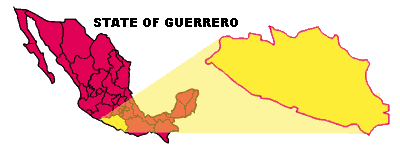
BAREFOOT BOYS MEXICAN TRIP N° 4
(By Noah Elhardt and Forbes Conrad, , 2006)
(All pictures by Noah Elhardt and Forbes Conrad)
Three Pinguicula species and hybrids in Guerrero, Mexico.

We visited a small, romantic village composed of an unnavigatable maze of quaint cobblstone streets. It is set on a hillside at roughly 2000 m. altitude.
Near of the town is a location that houses three species of Pinguicula: P. moranensis, P. parvifolia, and P. heterophylla (as well as U. livida, which we were sadly unable to find on this trip). The first species we came across was P. moranensis, which seems to be a bit of a roadside weed within its habitat. These plants were inaccessable high on the cliffside, but appeared to have beautifully dark violet-purple flowers. Nearby, P. heterophylla could easily be spotted because of its unique upright growth.
The flowers are pink from a distance but upon closer inspection have a distinct two-tone coloration pattern on their petals - white on the inside and purplish on the outside. As we continued on up the road we found more and more plants on the cliffside. Where the cliffside gave way allowing access to the top, I climbed up to get a better view of the plants at the top of the cliff. Imagine our surprise when we found plants that were neither P. moranensis nor P. heterophylla! At the time we were unaware of the third species (P. parvifolia), but these plants were not that species either! The leaves were reminiscent of P. heterophylla but much shorter, and distinctly maroon colored, whereas all of the P. heterophylla were pure lime green.
Nearby, we found what turned out to be P. parvifolia, though these plants were for the most part smaller and redder than the ones we had seen on our previous site.
.jpg) |
.jpg) |
It seemed
clear, then, that the plants were hybridizing. The flowers of the unknown plants
supported this theory. Note the P. parvifolia-like
flower morphology and the P. heterophylla-like
coloration pattern.
Another interesting hybrid flower:
.jpg) |
.jpg) |
Above the cliffs the terrain was composed of a lumpy hillside with many clay and
granite banks lightly forested with pines and oaks. These large-leaved oaks and
at least three other species we recognized as having noted at the previous
P. parvifolia site in Mexico state. The
west-facing hillside supported nice populations of both
P. heterophylla and
P. parvifolia - the former growing on
granite mounds and the latter on clay banks.
P. heterophylla :
.jpg) |
.jpg) |
.jpg) |
.jpg) |
|
|
.jpg) |
.jpg) |
.jpg) |
.jpg) |
In
several places various hybrids between the two species could be found.
The hybrid growing adjacent to a pure P.
heterophylla :
A cluster of hybrids and species:
.jpg) |
.jpg) |
In at least one location, we found plants that seemed to have been influenced by another species - perhaps P. moranensis. Note the long petioles and large size of the following plant :
Any
guesses at its parentage? Could it be just P.
parvifolia x P. heterophylla?
That's all for now. Hope you enjoyed the window into Mexico
Signing off,
Noah Elhardt and Forbes Conrad